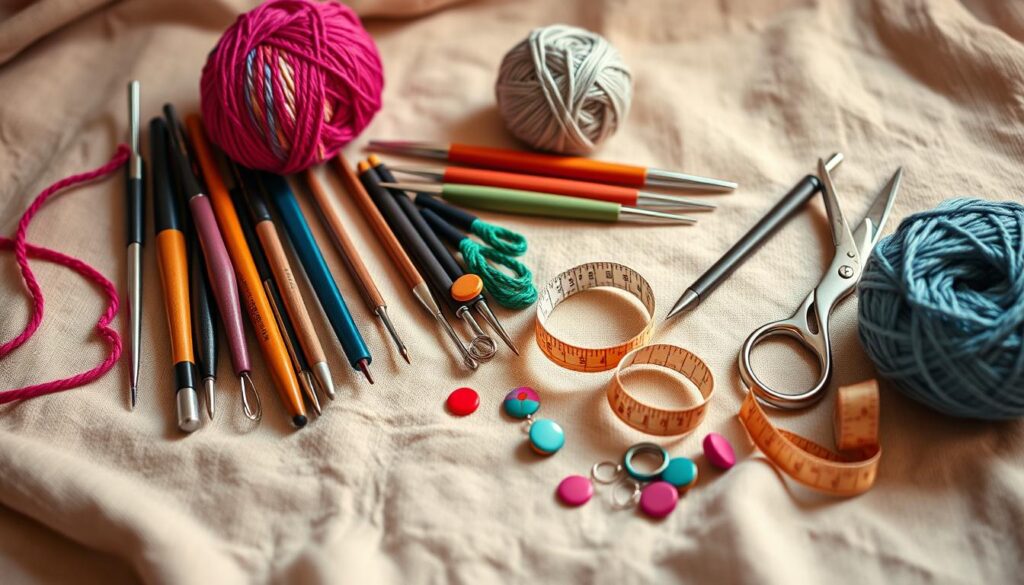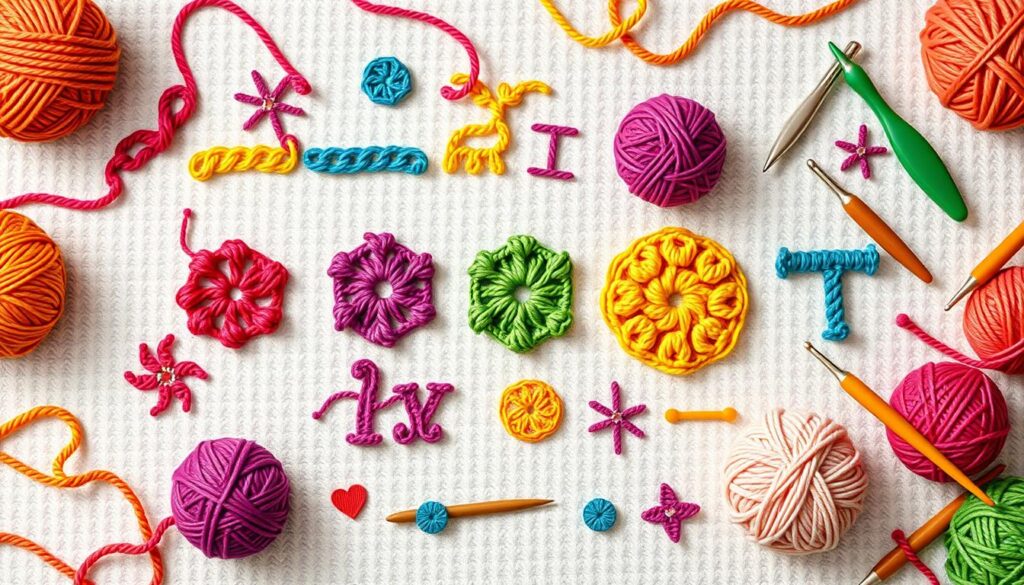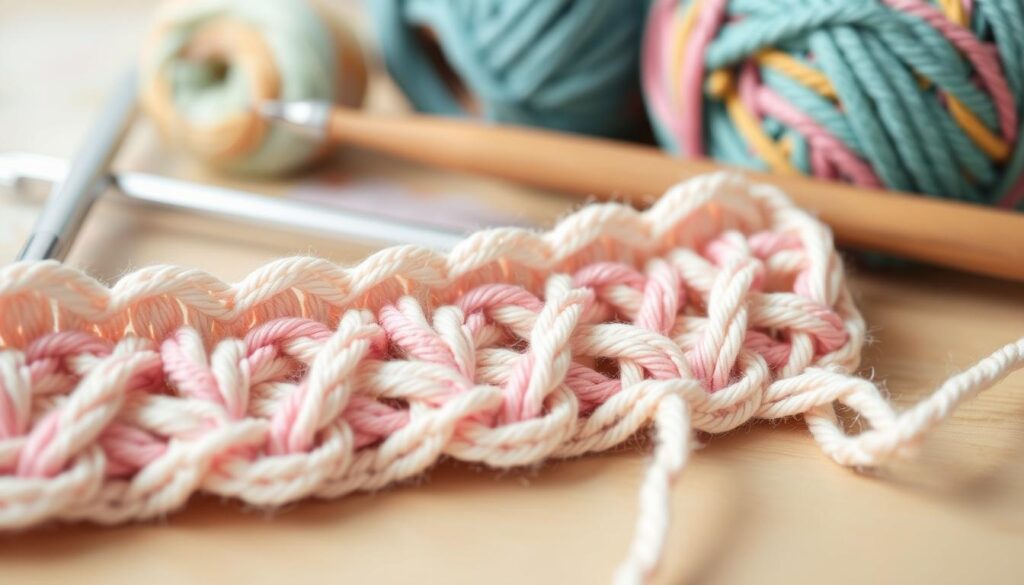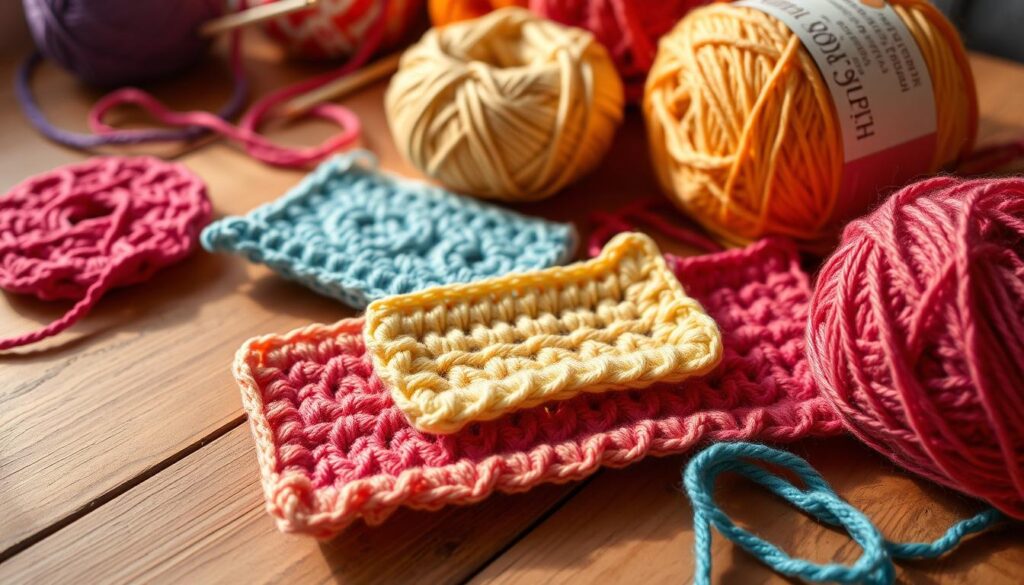Did you know that just 14 basic crochet stitches can make many different items? You can make sweaters and even crochet bees with them. These stitches are the base of all crochet projects. Knowing them well is key to making beautiful designs.
As a beginner, learning these stitches will boost your skills. You’ll also avoid common mistakes. Stitches like the chain stitch and single crochet are great for beginners.
The chain stitch is used in about 90% of crochet projects. It’s a must-know for beginners. The single crochet is also popular, used in 70% of amigurumi patterns. Learning these stitches lets you make many things, like blankets and clothes.
Key Takeaways
- Mastering 14 basic crochet stitches can help you create a variety of crochet projects
- Understanding basic crochet stitches is crucial to creating beautiful and intricate designs
- The chain stitch is the foundation for approximately 90% of crochet projects
- The single crochet stitch is a favorite among beginners, accounting for 70% of patterns in amigurumi
- Learning essential crochet stitches can help you eliminate common beginner mistakes and improve your skills
- Beginner crochet stitches, such as half double crochet and double crochet, are versatile and widely used in intermediate projects
- Practicing essential stitches consistently can improve your crocheting skills by approximately 50% within the first month
Getting Started: Essential Tools and Materials for Crochet
To start crocheting, you need the right crochet tools and crochet materials. The right tools can greatly improve your experience. A beginner crochet hook is key, and picking the right size and type is crucial. You can choose from aluminum, steel, plastic, bamboo, or wood hooks, each with its own feel.
For beginners, smooth, medium-weight yarn in a light color is best. You’ll also need crochet accessories like scissors, a tapestry needle, and stitch markers. Don’t forget a flexible measuring tape and a yarn needle.
Here’s a list of essential tools and materials to get you started:
- Crochet hook (aluminum, steel, plastic, bamboo, or wood)
- Yarn (smooth, medium-weight, and light-colored)
- Scissors
- Tapestry needle
- Stitch markers
- Measuring tape
- Yarn needle

Choosing the right tools and materials is key to a successful crochet project. With the essential crochet tools and crochet materials, you’ll be ready to create beautiful projects.
| Tool | Description |
|---|---|
| Crochet Hook | Essential for creating crochet stitches |
| Yarn | Available in various weights, colors, and materials |
| Scissors | Used for cutting yarn |
| Tapestry Needle | Used for weaving in ends |
Understanding Basic Crochet Terms and Symbols
Starting your crochet journey means learning basic crochet terms and symbols. These help you follow patterns and make your project. Knowing these terms makes reading patterns easier and ensures your project looks right.
Crochet symbols include abbreviations for stitches like Ch (Chain), Sl st (slip stitch), and Sc (single crochet). It’s key to know these to follow patterns well. Also, terms like “foundation chain” and “gauge swatch” are important for a successful project.
Here are some key terms to get you started:
- Chain (Ch): The foundation of most crochet projects
- Slip stitch (Sl st): Used to join two pieces of crochet work together
- Single crochet (Sc): A basic stitch used in many crochet patterns
Learning these basic crochet terms and symbols will help you make beautiful crochet projects. Always check the pattern’s glossary for specific terms. If you’re unsure, don’t hesitate to ask the pattern designer.

With practice and patience, you’ll get better at reading crochet symbols and terms. This will let you tackle even complex projects with confidence.
| Term | Definition |
|---|---|
| Foundation Chain | The starting chain of a crochet project |
| Turning Chain | A chain used to turn the work at the end of a row |
| Gauge Swatch | A sample of crochet work used to measure the gauge of a project |
The Foundation of All Crochet Stitches
To start any crochet project, you need to create a foundation chain. This chain is the base for your stitches. Its length will decide your project’s size. Most crochet projects start with a foundation chain of 10-20 chains.
Before starting, learn how to hold your crochet hook and yarn. Hold the crochet hook in your dominant hand. Keep the yarn in your non-dominant hand. This crochet hook hold helps you control your stitches.
Now, let’s create a foundation chain. First, make a slip knot on your crochet hook. Here’s how:
- Hold the yarn in your non-dominant hand, making a loop with the end of the yarn.
- Insert the crochet hook into the loop and pull the yarn through.
- Gently pull the yarn to create a small knot on the crochet hook.
After making your slip knot, start your foundation chain. Keep your crochet hook hold steady and your tension even. This makes your foundation chain smooth and stretchy.

Basic Crochet Stitches for Beginners
Starting your crochet journey means learning the basic stitches. These stitches are the foundation of all crochet patterns. They help you create a wide range of projects. The chain stitch, single crochet, and double crochet are the most basic stitches for beginners.
These easy stitches are the building blocks for more complex patterns. They help you develop the skills and confidence needed for more challenging projects.
Some of the key basic crochet stitches for beginners include:
- Chain stitch: The starting point for most crochet patterns
- Single crochet: A smooth texture suitable for scarves, baby blankets, and hats
- Double crochet: Taller than the single crochet, often featured in various crochet patterns
- Half double crochet: A combination of single and double crochet stitches, ideal for blankets and scarves
- Treble crochet: The tallest of the foundational stitches, measuring approximately 4 chains high
- Slip stitch: Used for connecting rows and creating flat invisible stitches
Mastering these beginner crochet stitches lets you create a variety of projects. You can make simple scarves and hats or more complex blankets and garments. With practice and patience, you’ll be able to move on to more advanced stitches.
Start with the basics and build your skills gradually. This will help you become a proficient crocheter.

By following these basic crochet stitches and practicing regularly, you’ll create beautiful and intricate patterns. Don’t be afraid to experiment and try new things. It’s all part of the learning process.
With time and practice, you’ll become proficient in these easy crochet stitches. You’ll be able to tackle even the most complex projects.
| Stitch | Description |
|---|---|
| Chain Stitch | The starting point for most crochet patterns |
| Single Crochet | A smooth texture suitable for scarves, baby blankets, and hats |
| Double Crochet | Taller than the single crochet, often featured in various crochet patterns |
Mastering the Single Crochet Stitch
To master the single crochet stitch, you need to know the basics. It’s a key stitch for beginners and is used a lot in crochet. With a single crochet tutorial, you can start your projects quickly.
The single crochet stitch is often shortened to ‘SC’ in patterns. It’s a basic unit in crochet. To make one, draw up yarn through two loops on the hook, leaving one loop. This action is repeated for each row to get better.
Step-by-Step Single Crochet Tutorial
Here’s a step-by-step guide to get you started:
- Create a starting chain of 10 stitches.
- Insert the hook into the second chain from your hook.
- Yarn over and draw up a loop.
- Yarn over and draw through both loops on the hook.
- Repeat steps 2-4 until you reach the end of the row.
Common Single Crochet Mistakes
Some common mistakes to watch out for when working with the single crochet stitch include:
- Incorrect tension, which can result in a too-tight or too-loose fabric.
- Missing stitches, which can cause the fabric to pucker or become uneven.
- Incorrect hook size, which can affect the overall size and texture of the project.
By following these tips and practicing regularly, you can master the single crochet stitch. This will help you create many beautiful crochet projects. Always refer to a single crochet tutorial if you’re unsure about any part of the stitch.
| Project | Single Crochet Stitch Count |
|---|---|
| Scarf | 100-200 stitches |
| Blanket | 500-1000 stitches |
| Amigurumi Toy | 50-100 stitches |
Double Crochet and Half Double Crochet Techniques
As you get better at crochet, learning the double crochet and half double crochet stitches is key. The double crochet stitch makes your fabric taller, changing how it drapes. The half double crochet stitch is a mix of single and double crochet, adding variety to your work.
Experts say the half double crochet stitch is a basic stitch for beginners. It’s taller than a single crochet but shorter than a double crochet. This makes it great for many patterns. To start, you’ll use a yarn-over, which is different from the single crochet.
Some important things about the half double crochet stitch are:
- It can sometimes count as a stitch, depending on the pattern specifications.
- Creating an increase by making 2 half double crochet in one stitch results in a 100% increase in the stitch count.
- The half double crochet decrease combines two stitches into one, effectively demonstrating a decrease of 50% in stitch count.
The double crochet and half double crochet stitches are crucial crochet techniques for many projects. They’re used in baby blankets, pillows, and sweaters. Mastering these stitches will help you create complex patterns and textures. With practice, you’ll get better at these essential crochet techniques.
Advanced Essential Crochet Stitches
As you get better at crochet, you might want to try more complex stitches. Stitches like the treble crochet, shell, and puff can make your blankets, scarves, and beanies look amazing.
These stitches are built on basic ones, showing you’re building on solid skills. Start with small projects to get the hang of them. Then, move on to bigger ones. Mixing different stitches can lead to cool patterns.
Some top advanced crochet stitches include:
- Treble crochet stitch
- Shell stitch
- Puff stitch
These stitches are great for making everything from fancy lace shawls to cozy blankets. Learning them will help you make more intricate and beautiful projects.
With time and effort, you’ll get good at these stitches. Start with small projects and work your way up. Don’t be shy to try new combinations for unique patterns.
| Stitch | Description |
|---|---|
| Treble crochet stitch | A versatile stitch that can be used to create a variety of textures and patterns |
| Shell stitch | A delicate stitch that creates a shell-like pattern, perfect for lace shawls and baby blankets |
| Puff stitch | A textured stitch that adds depth and visual interest to crochet projects |
Troubleshooting Common Crochet Stitch Problems
As you crochet, you might face issues like uneven edges, dropped stitches, and tension problems. These can be annoying, but there are solutions. First, figure out what’s causing the problem. For example, uneven edges might come from counting mistakes or uneven tension.
Common mistakes include not counting rows right, getting confused between U.S. and U.K. terms, or using the wrong hook size. To avoid these, read the pattern fully before starting. Also, make a gauge swatch to keep your tension even. About half of beginners struggle with tension, leading to stitches that are too tight or too loose.
To fix uneven edges, re-count your starting chain or adjust your tension. For dropped stitches, pay close attention to the pattern and use a stitch marker. Keeping your tension even is key to avoiding these problems. By following these tips, you can fix common issues and make your projects look great.
Remember to leave a long tail for weaving in ends, count stitches carefully, and look up tutorials when needed. By mastering these skills and knowing common problems, you can make beautiful, professional-looking crochet projects.
Combining Different Crochet Stitches in Projects
Combining different crochet stitches can make your projects stand out. Mixing various stitches adds depth and beauty to your work. For instance, you can mix single crochet and double crochet for intricate designs. Or, try shell and puff stitches for a textured look.
Using different stitches lets you create many patterns. These patterns are perfect for making blankets, scarves, and hats. Start with simple projects like scarves or dishcloths. Then, move on to more complex items like blankets or sweaters.
- Combining single crochet and double crochet stitches to create a chevron pattern
- Using shell stitches and puff stitches to create a textured blanket
- Combining half double crochet and treble crochet stitches to create a intricate lace pattern
Experimenting with stitch combinations can lead to unique and beautiful projects. It’s a great way to show off your style and creativity, whether you’re new or experienced. Combining stitches can elevate your skills and help you create something truly special.
Conclusion: Taking Your Crochet Skills to the Next Level
Now that you’ve learned the basic stitches, it’s time to get better. With regular practice and a desire to learn more, you can explore new things in crochet.
Set aside at least 30 minutes each day to work on your crochet skills. Joining a crochet group or class can also help you get better, with 60% of crocheters saying it improves their skills. Trying at least two new projects a month will make you more comfortable with advanced crochet techniques and boost your confidence by up to 40%.
Trying different yarns like silk, wool, and cotton can add variety to your work and make you 25% more creative. Also, learning to read patterns and charts will make you 70% more confident in your crochet skills. This is a key skill for moving forward in your craft.
With hard work and the right tools, you can take your crochet to new levels. Keep practicing, try new things, and don’t be afraid to experiment. The world of crochet skills and next level crochet is full of possibilities.

